What is Hoodening?
Defining features
Attempting to define hoodening, hoodeners, and hooden horses is a perennial problem. We see the terms used in a way that is at best 'flexible', but deep down, rather irritating — it seems anyone using an equine disguise to do anything now feels entitled to call it 'hoodening', regardless of season, structure, stance, sequence, composition, location, activities, heritage, or anything else we'd see as defining features. Since we've been doing it for well over 50 years even with our current team, and much longer before that with previous generations, we're unashamedly precious about the words used. Merely having a wooden/hooded horse doth not a hoodener make!
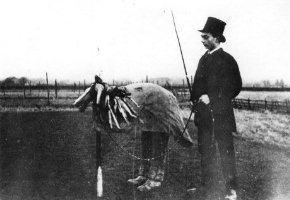
When Ron Hubbard posed the question "What are three characteristics of hoodening?" during the panel discussion at the Animal Guising exhibition in Maidstone (February 2023), our George's answer was:
- the use of a dark, stooping (not dancing) horse;
- the location of East Kent; and
- the time of midwinter, generally around Christmas or the winter solstice.
This was partly prompted by various groups claiming to do hoodening despite using pale/upright horses, outside the traditional area, and at other times of year. It was then amplified by the author/researcher George Frampton, who clarified that the horse is a wooden effigy, and added that the custom involves humorous impersonation by lower classes of their "lords & masters", ranging across a wide area to solicit alms. For the structure of the horse itself, see our separate page on hooden horses.
Pre-20C groups
Despite the wish to draw boundaries around what is, and is not, hoodening, there is inevitably some ebb and flow. During the discussion above, it was noted that the earliest record of the word did not even mention a horse, and looking through historical references, some natural variety is apparent, e.g.:
- 1735: no mention of horse
- 1809: head of a 'dead horse' (no mention of wood); 'with handbells', singing carols and songs
- 1820s: men dressed as fools and a woman; 'horse’s head' mentioned again (no mention of a supporting stick); hoodeners engaged in tomfoolery with sticks and bladders
- 1832: a 'Molly', and several musicians on violin and fife
- 1840: two eyes bored into the horse’s forehead, with a candle showing through; 'no singing' (but carollers were called hoodiners)
- 1846: horse's Rider mentioned
- 1849-1896: music came from a sheep-bell in each hand
- 1850s: specific hoodning song; All Souls mentioned as well as Christmas
- 1855: no musical instruments; numerous teams, each of 5 people: Groom, Horse, Jockey, Molly, and one to gather money
- 1857: bells (not handbells, but on a stand, beaten)
- 1860: party consisted of Hoodener, Driver, Jockey, Molly, and 3-4 musicians playing concertina and ‘bones’
- 1872: two old men singing on Christmas Eve, called hoodeners but no horse
The records collected by Maylam and within our own team show further variation in the early 20th century.
- 1905: Molly playing triangle, other musicians with tambourine and concertina; team also includes Horse, Rider, Wagoner
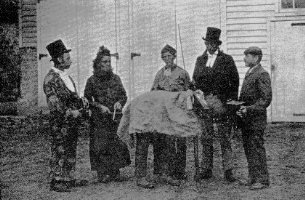
- 1906: no Molly, just four people: horse, leader (with triangle), musicians on tambourine and concertina
- 1920: Rider is Boy and gets thrown off horse; performances include latest hit songs
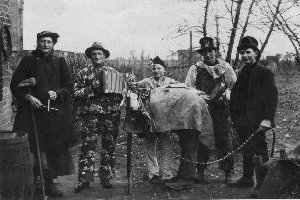
Modern times
Many (but not all) of the above mention music in some form. When we resumed after WW2, we had a shortage of singers within the team, so decided instead to perform a play — our own tradition, which has continued for over fifty years since. We also had several handbell ringers and carollers with us initially, but the number made it impractical for some hosts to fit us all in, let alone feed & water us, so that aspect declined after a while, and we made do with our own voices, combined with those of the audience in community carols. Another change that came about as we grew older — and heavier — was that the horse no longer found it so easy to support a rider, nor did the rest of us find it so easy to lift the corpse during the funeral procession (one script contained the lines 'Christ, he's heavy!' and proved to be quite prophetic, because we couldn't even get him off the floor… it brought the house down).
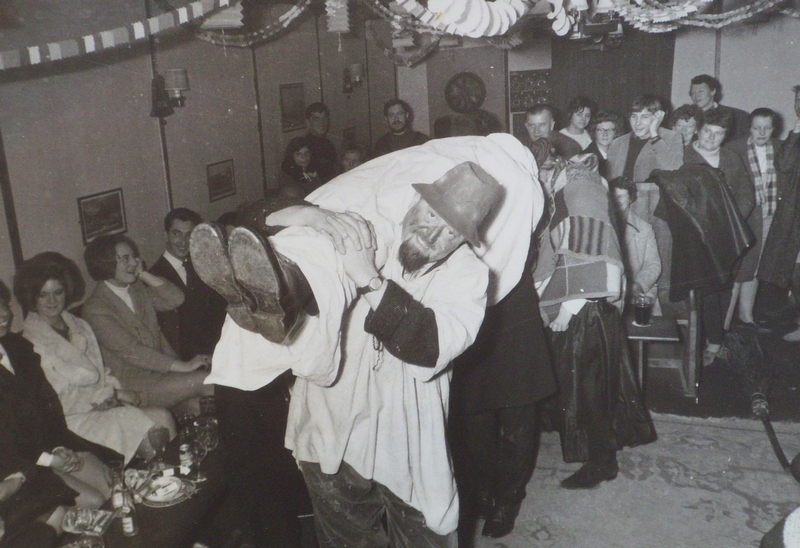
Variants
The short list here focuses on hoodeners — i.e. those few who hooden, do wholly hooden, and do nothing but hooden — while those doing hoodening-like activities alongside other things are shown in various sections below, and other customs which have no claim to the hoodening name but can be regarded as vaguely 'similar traditions' are described on that separate page.
- St Nicholas-at-Wade with Sarre: the oldest team, and creator of this site, so unless otherwise specified the information here all relates to our team. Just as various indigenous peoples have been named by their own word for 'people', and perhaps similar to the way that Britain, as originator of postal stamps, is the only country not to put its name on the stamps, we tend to refer to ourselves simply as 'The Hoodeners', because for a long time we were the only ones around anyway.
- Deal Hoodeners (archive site: like many below, they're not great at maintaining an online presence). Next to St Nicholas-at-Wade with Sarre, this is the only other group with a traceable lineage, of sorts, insofar as they picked the brains of a grandson of an original Deal hoodener when reforming in their second (1974) and third (1997) incarnations. The original Deal horse was lost, and 1974's Hengist too went away for some decades, so the current (unnamed) horse is a 1997 birth. Their focus is exclusively on music — particularly sea shanties — so the horse does not play a major role.
- Whitstable Hoodeners (Facebook). Founded by Mark Lawson in 1984, using a succession of newly built horses and a static play based on Cheshire souling (see similar traditions). Mark also created the 'Ancient Order of Hoodeners' (or rather, the phrase), that even garnered a serious mention from Ron Hutton in Stations of the Sun followed by numerous other publications… although it was in essence just a joke, possibly inspired by the 'Graund Order of Guisers' who also started around that time. The 'Order' never actually did anything! Whitstable have some overlap with the Dead Horse morris side, and as Mark is a keen 'folkie' often participating in festivals such as Broadstairs or Banbury, their play almost became a franchise, being adopted/adapted by several other morris sides wanting to dip a toe into our hoodening custom, as shown below.
- Canterbury Hoodeners — founded in 2016, using a horse made by James Frost in 2011, and a play based on the Tonbridge one (see below), which in turn is based on Cheshire souling and Dorset mumming.
Hop Hoodening
Barnett Field, a great force behind the international Folkestone Folk Festival, created the East Kent Morris Men for the 1953 coronation celebrations, and a brown horse to accompany them. He named it a hooden horse, although its appearance throughout the year at morris dancing events (only) means its claim to that name is rather superficial, and it's rather a morris beast (see similar traditions). It did make an appearance at the opening of the Wickhambreaux Hooden Horse pub in 1956, and this led onto the inauguration of a new custom in 1957, called Hop Hoodening, held each autumn at Canterbury Cathedral and now run by Wantsum Morris. Various horses such as the white Invicta appear there, but as morris beasts.

Hoof in two camps
Several groups claim either to have a 'hooden horse' or to do 'hoodening', but often this is just an adjunct to other activities — mainly morris dancing or mumming (mentioned more on the similar traditions page).
- Ravensbourne Morris — their first horse was apparently a copy of 'the one from Sarre', presumably our Dobbin. They do mumming and wassailing as well as dancing, and were present at the renaming of the Wickhambreaux Hooden Horse pub in 1956.
- Hartley Morris, from West Kent. (An older archived site has some interesting pages on their horse.) Added one horse, then a second, from the early 1970s, 'based on Hoodening records' — but the horse only performs as an ancillary to the morris dancers.
- Headcorn Morris — now defunct. The older archived site has some good information on their 'hooden' horse Jason and his origin.
- Sandgate Hoodeners — based around a morris side, and formed by Martin McKenna in around 1989, using Whistable's Cheshire souling play, and a horse copied from Walmer. After Martin's death in 1998, Doug Quinney continued but despite a few commemorative 'Day for Martin' events the group became defunct by around 2013 (Homer Sykes has some photos of Sandgate Hoodeners in 2012). One member moved to Farnborough, passing certain aspects to a local mumming team. What became of the Sandgate horse is unknown.
- Rabble Folk Theatre — another group with almost no online presence, so it's often hard to tell if they're still active. Horse commissioned by Gail Duff in 1979, based on Barnett Field's model, but largely a morris / mumming beast. Sometimes use a version of Whitstable's Cheshire souling play.
- Tonbridge Mummers, Hoodeners and Howlers (archive site). Founded in 1981 by Fran & Geoff Doel, and once featured on the BBC. The Doels are possibly best known for their publications about folklore,including Mumming, Howling and Hoodening: Midwinter Rituals in Sussex, Kent and Surrey. Now they have moved to Littlebourne, this group has been largely superseded by the Canterbury Hoodeners (see above).
- Wychling Hoodeners (near Faversham) — again, hard to tell how active they are now, but they apparently perform/performed 'mystery plays' (in the medieval sense).
- Dover Tales (Facebook) — Nic Lucas and Barry O'Brien are very active, with a wide range of performances (hoodening, historical talks, plays, music) and regular updates by email. Originated with Sandgate (see above).
Invictus Mugistis Equinus
Broadstairs Folk Week can attract over a million people, and their 'hooden' horses are the first way many encounter the tradition… even forming the symbol of the event. However, it's clear that they're really a form of morris beast, as they stand upright and dance, in summer. Having said that, beasts in the morris are generally supernumeraries to a dancing side, but the twelve members of this Broadstairs brigade (whose name is dog-Latin for ‘undefeated horses neigh’) are independent, and dance with each other, as well as 'causing mayhem' throughout the festival. Their origins go back to Jack Hamilton (friend of Barnett Field, and founder of Broadstairs Folk Week) in the 1970s. It has been said that they once performed in the Royal Albert Hall, but that might be conflated with Ravensbourne.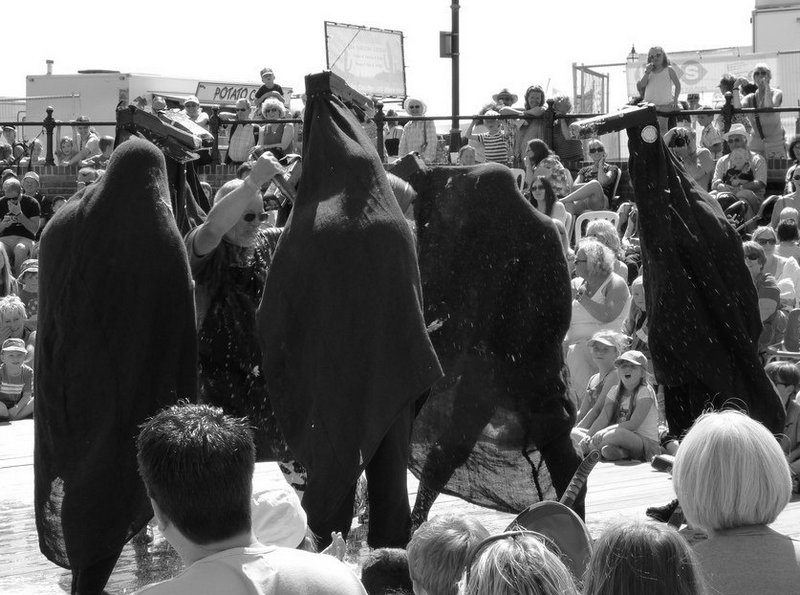
The future
If the tradition is to continue into the future, it will need future generations of hoodeners — and where will they come from? Our experience so far is that we've always managed to find someone foolhardy enough to take up the reins… but there's no guarantee, especially as society continues to change. As shown above, we have seen other groups disappear. Over a century ago, Maylam was concerned about the custom potentially dying out (and indeed there were numerous reports over the 100 years before him that it had already died out!) — well, rumours of our demise were exaggerated. But as Frampton noted, the makeup has changed: modern hoodeners are seldom the agricultural labourers of the past (our current lineup ranges from a retired monumental mason through to a Japanese interpreter). Looking at other teams, those showing interest in recent years have tended to come from the 'folk' scene (along with a few pagans), meeting via that route. It must be stressed, this is not how the original hoodeners were, and within our own team, the number of 'folkies' has always been a minority. Instead, we are simply members of the same village community.
There have been suggestions that hoodening should be registered with UNESCO as an intangible cultural heritage, 'to protect it'. We are somewhat wary of this, as protection can imply calcification, getting stuck into lifeless repetition and reenactment rather than a living tradition free to evolve how we choose. In addition, we've not seen a need for 'protection', as we see no threat to our existence, and no need to recruit outsiders just to preserve some centrally dictated notion of what hoodening can and can't be. Moreover, even if some unforeseen circumstance, a 'black swan' were to cause our team to cease its activities, that could be seen as natural demise, and preferable to unrelated people artificially prolonging its life.
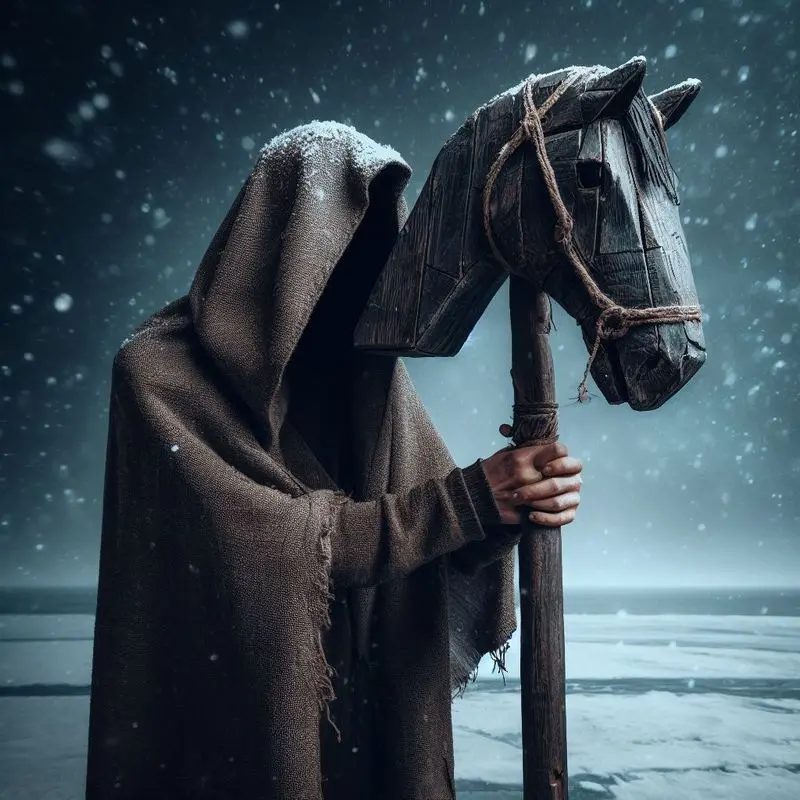
Yet pretending to be sole guardians of the hoodening tradition would be arrogant, and perhaps there is some justification behind calls to permit diversification. If a troupe of mummers from West Kent write a new play focused on a 'traditional' horse they have made (rather than St George, the doctor, saracens and so forth), and then perform around local houses one midwinter evening… is that heresy or homage, innovation or cultural appropriation? Do they become hoodeners for that day, or is it a protected title? If some members of a morris side become unable or unwilling to dance, and instead start borrowing the side's beast for more dramatic (or musical) performances, at what stage can they legitimately call themselves a hoodening team?
We have performed in West Kent at midday in summer. It felt very strange, and we certainly won't make a habit of it. But more importantly, we didn't actually 'hooden' that day: we merely showed them what hoodening looks like, and the distinction, though pedantic and perhaps arbitrary, feels crucial. Similarly, mummers demonstrating their interpretation of hoodening is fine… but assuming they've not abandoned their usual activities, if the core of what they do is unchanged and if they still identify as mummers, then in essence they are still mummers. If, however, they evolve until their primary identity is that of hoodeners… then it would mean that the definition has evolved too, and for a living custom, that's a healthy thing.